test url
Author: Jessica
How to Communicate on Social Media During the COVID-19 Crisis
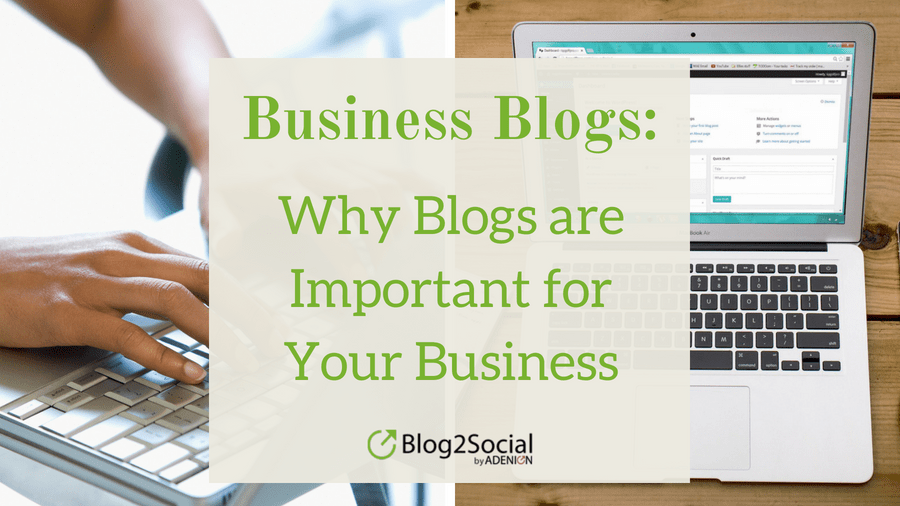
The aftermath of the coronavirus (COVID-19) outbreak will leave an impact on all people and organizations around the world. This article will guide you on how to communicate on social media with empathy and efficiency throughout the crisis.
Editor’s Note: This article is part of a series to help you navigate your marketing strategy during the current COVID-19 crisis. To explore a more strategic set up of your communication master plan, please take a look at:
- How to Handle the Coronavirus Crisis: Communication Strategies for your Business
- Essential Tools for Crisis Communication (coming soon)
- Tips and Tools for Working in HomeOffice (coming soon)

A global crisis is not the time for “marketing as usual”. Whether your business is directly or indirectly affected by the current situation, everyone should now be using a crisis communication protocol for social media.
Even, if your business is still thriving, a crisis is not the time for publishing regular company announcements, new product releases or sales messages.
Mind the specific crisis situation of your customers and community
- Your audiences may be severely impacted or have friends or family suffering or even died from coronavirus.
- Most people are fearing for their health and safety.
- They may be facing quarantine restrictions, personal worries and concerns due to high-risk factors.
- Businesses are faced with severe interruptions due to decentralized work environments, store closures, changes in demand, supply chain issues, or any other of the many business challenges coming up.
- Employees have to cope with disruptions in their day-to-day routine, overtime or financial constraints due to economic lockup.
- Many organizations and solopreneurs are fearing for their livelihood.
- Customers are becoming confused and unsettled due to the closing of shops and service points and an impending shortage of supplies.
- “Social Distancing” is taking its toll on human relations as well as on society.
To appropriately get your message across, your crisis messages and information should be:
- relevant to the current situation,
- reliable and reassuring to built trust and loyalty,
- guiding and assisting to help your audiences cope,
- supportive and encouraging for your audience,
- empathetic to keep up the spirit and build confidence,
- consistent and up-to-date as developments unfold
Take a look at Twitter recommendations on adjusting your brand voice for COVID-19.
Prepare for a consistent flow of current updates, breaking news, stories and valuable to tie your customers and communities to the important lifeline of communication.
Here are essential tips, content ideas and examples on what and how to communicate on social media to connect with your audiences throughout the COVID-19 crisis.
#1 Initial response to the crisis and current updates
The coronavirus crisis caught us all more or less off-guard. And the impact of the crisis is still evolving from day-to-day. New government rules and quarantine restrictions force people to stay home and companies to close or change operations. Rumors are spreading as fast as the virus itself. Crisis communication needs to be activated with speed and clarity to keep customers and communities in the loop.
If any of your business operations have changed, such as your service hours or how you’re working, let your customers know.
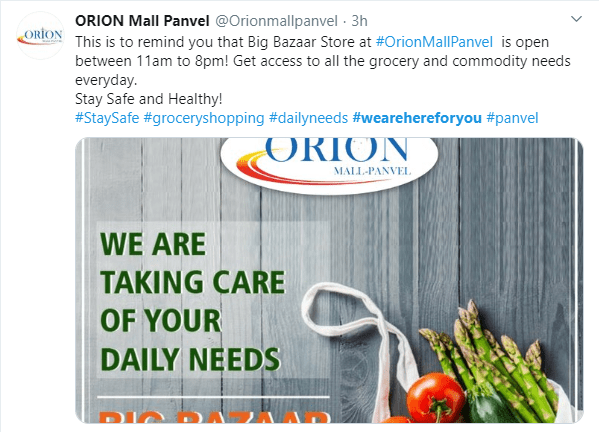
Many brands drive customers to online stores or drive-thru services, due to contract restrictions. Providing transparency on why you’ve decided to close, how long your store is expected to stay closed and how you will be serving customers in the meantime is a critical way to keep your customers loyal.
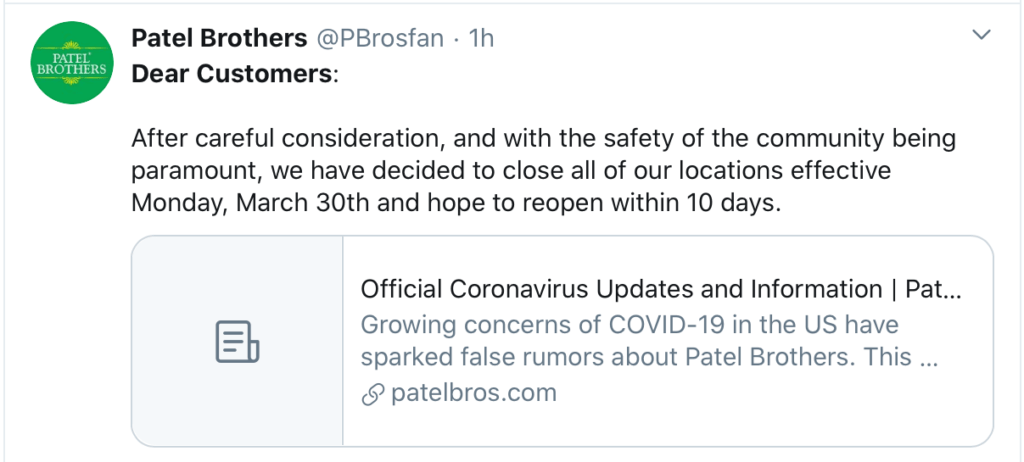
Communicating your decision with transparency and clarity shows your customers you keep up-to-dated and you care for their and your employees’ health and security.
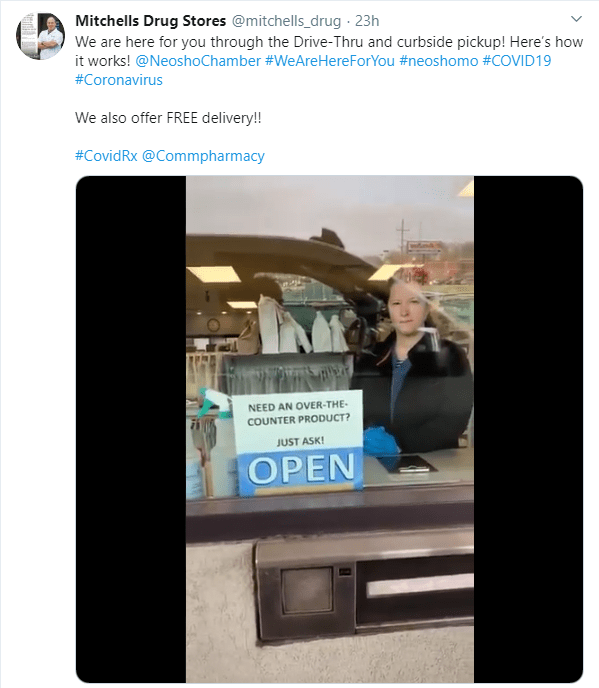
Publish this information on your website as well as on your Google My Business. Send your information per email or newsletter to reach your customers and subscribers directly.
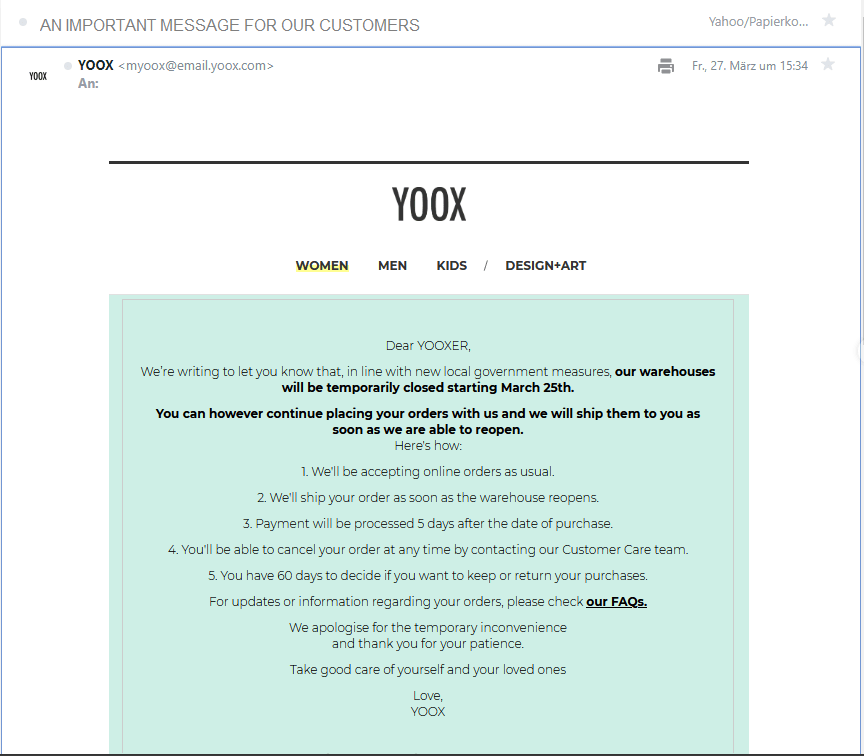
Share your current coronavirus updates on all of your social media profiles and pages. Think about creating additional social media posts to keep your customers informed about any upcoming changes.
Promote new service options
Many businesses, restaurants, and artists who had to close their shops and premisses and cancel events due to the lockup are looking to find new opportunities to serve their customers in order to survive.
- Restaurants, laundries and flower shops are offering pick-up or delivery services.
- Fitness and Yoga studios are offering live streaming sessions and video-trainings.
- Artists are offering online events
- Schools, universities, and teachers are offering online learning and tutorials.
New services have to be promoted consistently to reach your audience as well as new prospects. Here are some examples:
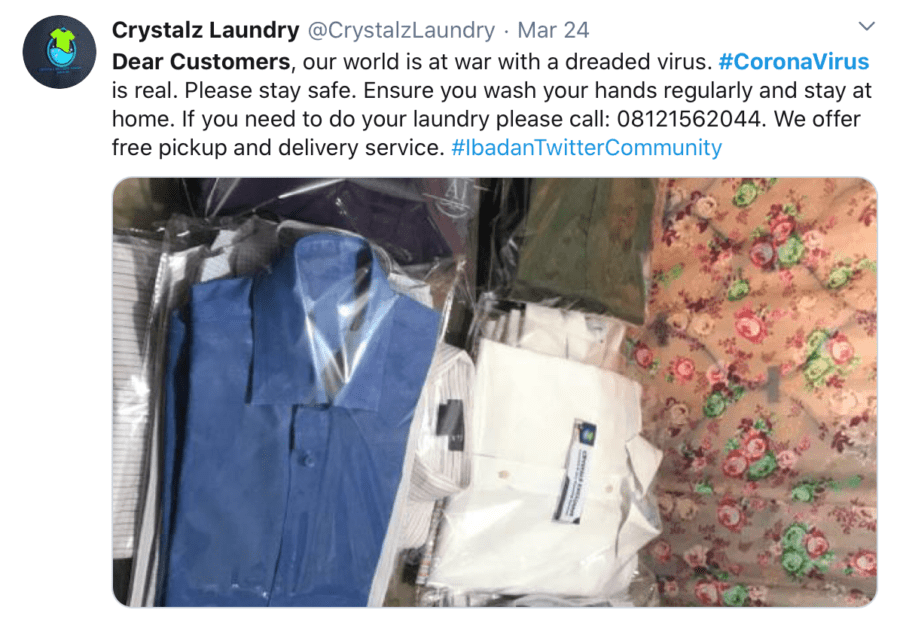
ComeKeto Restaurant offers extra fast delivery
Nurture your existing customers
Understanding the current needs of your customers is important for fostering the relationship with your audience. If you show empathy for what your customers may be dealing with personally and professionally your existing customers will stick around and remain loyal beyond the duration of the crisis.
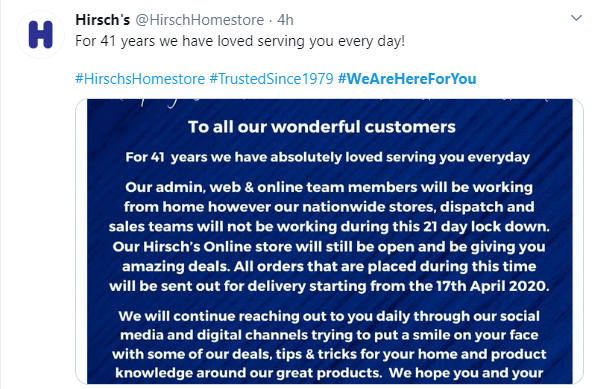
#2 Don’t hard sell – be helpful and supportive
The crisis situation does not mean you cannot sell at all. However, there are certain methods and messages that you should avoid.
Whether your business or store is closed or remains open, many brands are now encouraging their customers to shop online, to help practice social distancing and ensure the safety of customers and staff. This is a great way to encourage customers to support their favorite businesses, even when the doors are closed.
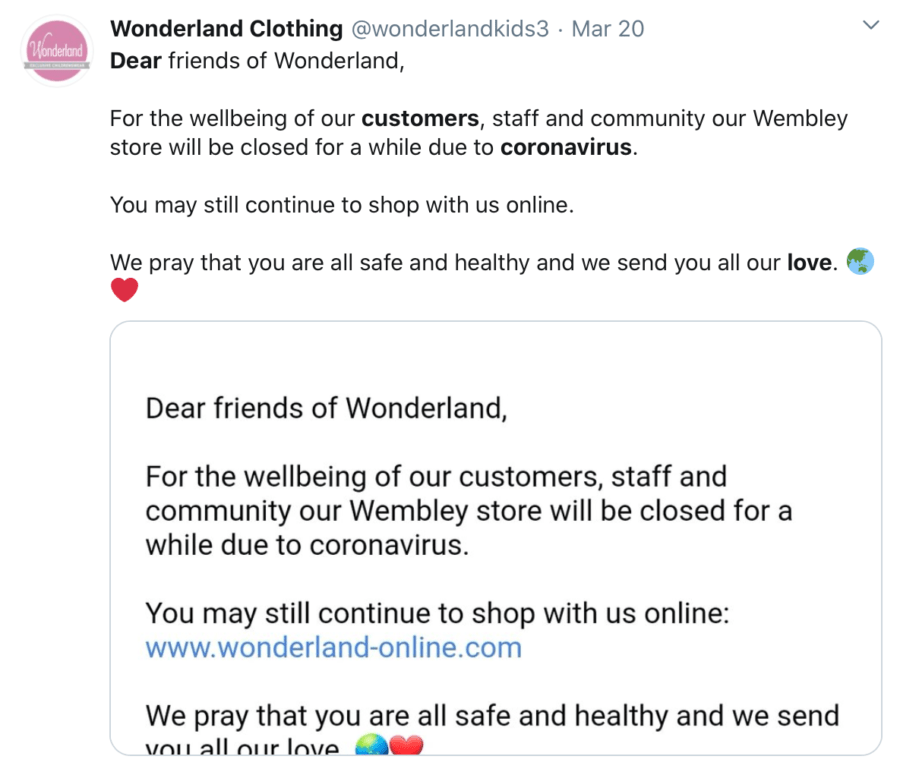
Whatever your situation is, do not post hard sale offers, because people might perceive this as insensitive to the impact of the crisis or that you are trying to make a profit off their situation. For example, if you want to give your customers a coupon or a discount, don’t use your usuals promotion language. Don’t call your discount code with anything associated to “coronavirus” or “COVID-19” to represent your brand.
You can well promote your products, but adapt your communication to the crisis situation. Offer help and show you care about your customers’ current situation. For example,
- offer free delivery to enable people to stay at home.
- promote special services or discounts for the elderly or for workers in the social service or national health service.
- offer free upgrades to help customers meet current challenges or demands.
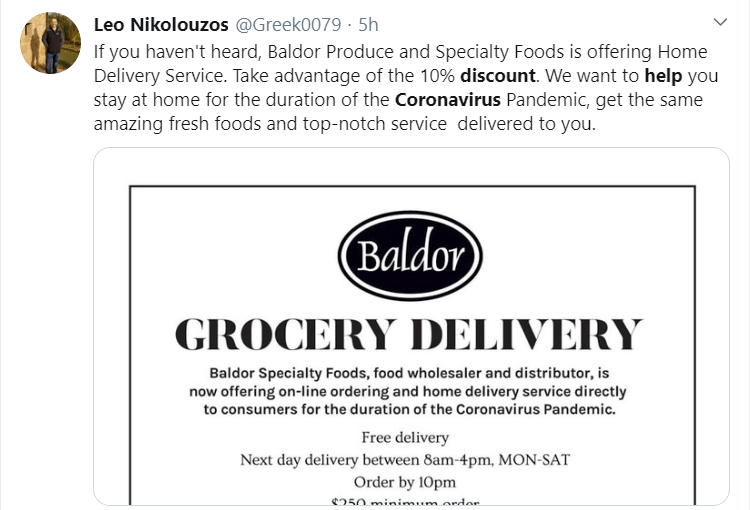
Alternatively, donate a portion of your proceeds to help your community, or offer your services or products to people or organizations in need of help at this time. This will work good for your reputation and your PR as well.

Review automated and scheduled content
Audit your automated emails and scheduled social media posts, if your messages are still relevant and appropriate in the light of the current situation.
Review your content calendar once a week and delete or adjust all messages that could be considered insensitive.
You probably need to make only small tweaks to your message by adjusting your tone or changing your marketing phrases with some empathetic words or by adding commonly used hashtags like #staysafe #stayhome #love #hope.
#3 Use valuable content for your crisis communication (content marketing)
When people are confronted with unprecedented challenges to their daily lives as well as to their business environments, helpful and assisting information to cope with the current challenges are very welcome. This kind of information will attract customers as well as prospects. For example,
- Provide tips and guidelines relative to your industry, for example:
- remote collaboration with online-tools,
- live-streaming or video conferencing,
- experience from employees working at home.
- Share tips for home training, healthy eating, and cooking, or how to cope with social isolation and quarantine.
This kind of content marketing is a safe way to promote your products and services. They will show your audience you understand their current needs and strengthen your reputation as an expert for their requirements.


Ask your community
There is no general rule on what and how to communicate with your customers aside from basic updates. It will very much depend on the specific situation of your customers. As more unpredictable changes are likely to unfold in the coming weeks, you will need to constantly adapt to the current situation and adjust communication strategies as needed.
If you are not sure, what is the best way to communicate with your community, just ask them what information is the most important for them and how they want to hear from you?
Listening to your community and monitoring their response to your current communication strategy will provide you with the necessary insights to meet their needs.


#4 Show you care for staff and customers
Many shops are currently struggling with severe changes in processing and demand, causing employees to cope with disruptions in their day-to-day routine, their work environment or work overtime. Aldi USA says thanks to customers and staff
Showing that you care for your staff strengthens your employer branding as well as your reputation as a responsible and caring employer.
Show your responsibility and measurements
“Social distancing” is becoming more and more vital for people to stay safe from the virus. Communicating the measurements you are taking to ensure the safety of your customers as well as your staff is a good way to show your responsibility. Iceland Foods shows slideshow with advice for customers and staff to ensure safe shopping
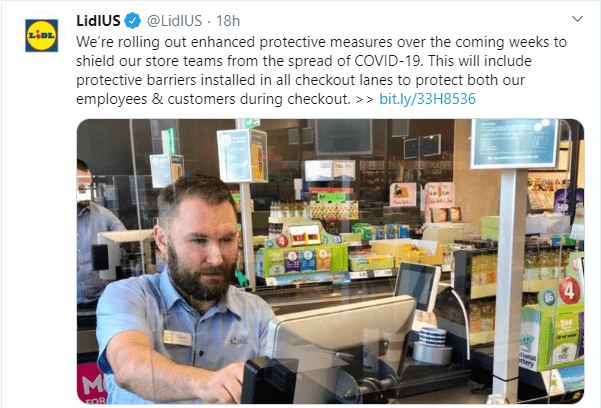
Tailor your messages to your audiences. While it is good for your staff to know what measurements you are taking to ensure their safety, your customers will only want to know this as far as your measurements affect them to stay safe.
#5 Share important information about the coronavirus crisis situation
Current updates about the crisis situation, the virus and how to protect yourself is important information for your customers as well as for your staff.
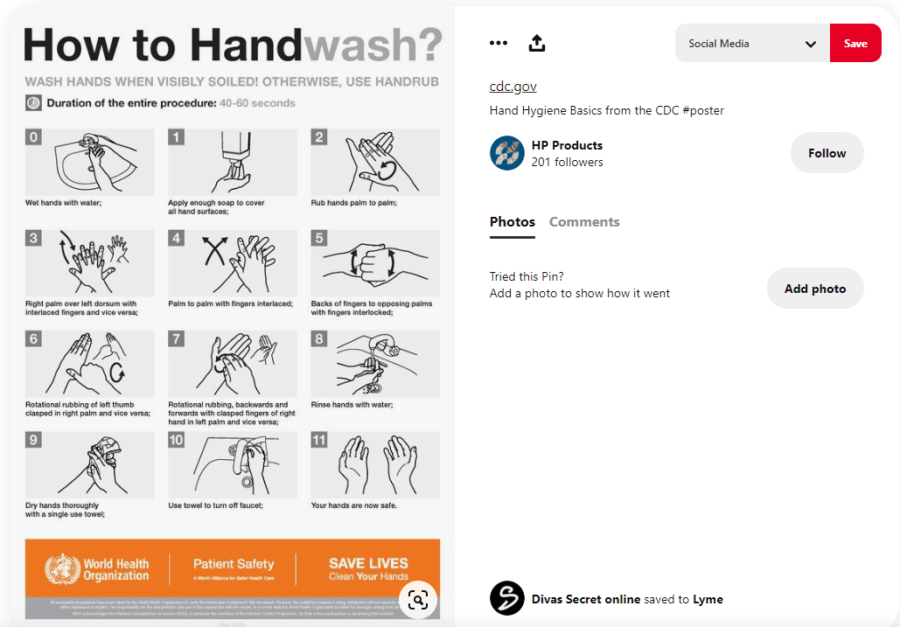
However, if you share this kind of information make sure to share information from official and highly trusted sources, such as:
- WHO daily bulletins on the status of the virus and instructions for dealing with the virus.
- COVID-19 myths for preventing misinformation by fake news and rumors.
- Travel advisories and safety information from national health authorities and ministries for foreign affairs as far as this affects your customers or partners.
- Official announcements from ministries for embargoes, civil unrest or disruptions of supply chain management as far as they affect your business.
Regardless of your own opinion about official measurements and announcements, refrain from talking politics or taking light on the risk of the virus or recommending your own personal advice for the handling of the crisis or health protection on your business pages.
All social networks have started to delete posts with alleged harmful medical misinformation. Whether legitimately or not, you don’t want your business or brand to be associated with spreading fake news. So stick on to trusted sources about resources for your community.
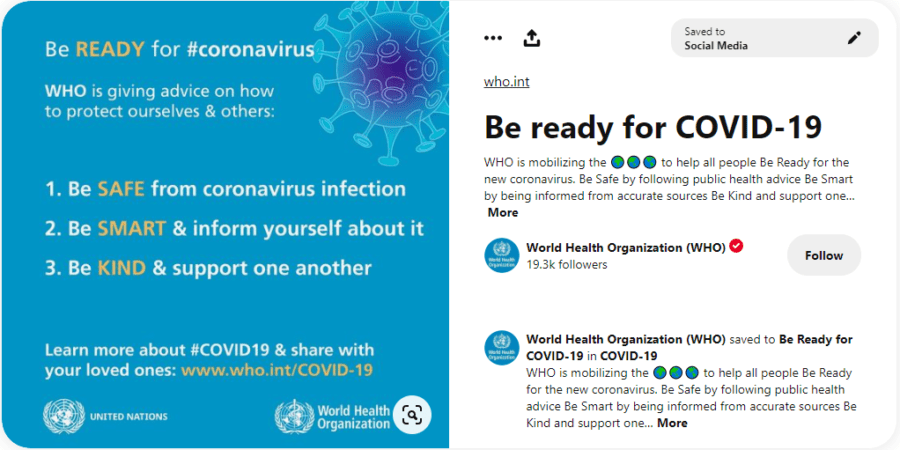
#6 Share content unrelated to the coronavirus
Social media is not just about posting breaking news. The current crisis situation does not mean you have to suspend all other forms of communication.
When people are confronted with so much overwhelming and alarming information on the virus, distractions can be welcoming. It just depends on how you convey these messages and on the specific situation of your customers.
However, as tensions rise, people become easily offended on social media. Make sure not to upset people with your content to avoid putting your reputation at risk.
Spread some love, joy, and entertainment
Find entertaining ways to delight your customers if it makes sense for your industry or brand. Try to find the perfect balance between lighthearted and compassionate communication in-between your official business updates.
Share funny images or funfacts on situations everyone is experiencing these days, for example shortage of toilet paper or “Hamsterkäufe”:
Share an experience or give ideas for those staying at home in isolation or with kids and family.
Share experience from your staff or your current work environment. However, refrain from posting photos from your staff with cats and dogs in cozy home office environments, when your customers work in jobs where the home office is impossible or are struggling with fear for their livelihood.
Share words of love and hope with your customers and community:
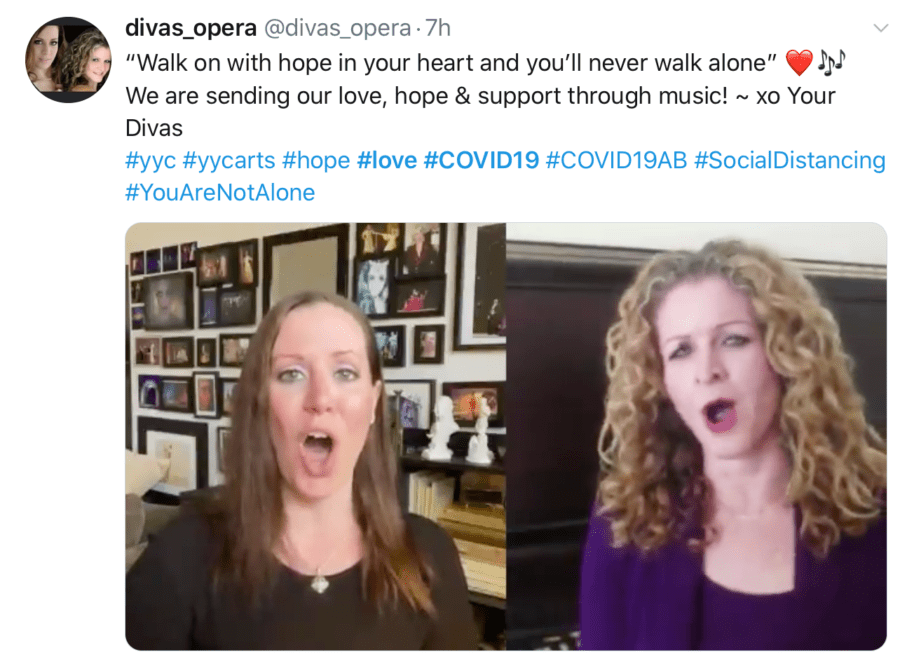
Praise and thank others for their engagement during the crisis:

#7 Publish and share across all your channels
Whether your business is closed or currently facing high demand for specific products or services, whether you are struggling to get stock, organizing delivery or lifestreaming, keeping your customers and community informed is now the demand of the day.
By keeping customers updated on changes in business hours, service options or estimated times of delivery you can reduce frustration and prevent them from looking somewhere else.
To make sure you reach your community and the public with your messages, publish and use all the traditional and social media channels available to you and tailor your message to your audiences.
- Website and blog: consider creating a special landing page for coronavirus updates and resources:
Example: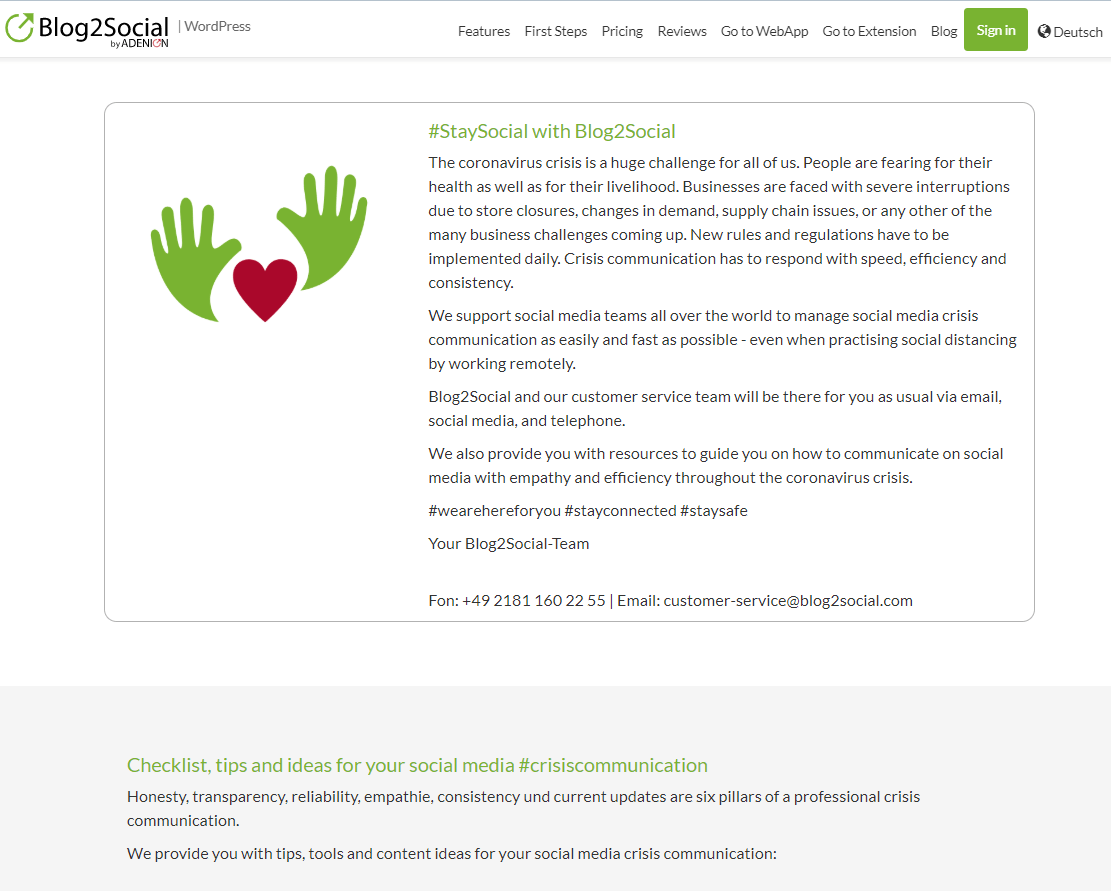
- Update current information about changes in opening hours or contact information on your Google My Business profile and use Google Posts for your current COVID-19 updates.
Example:
- Publish press releases and ad hoc news for your business updates on coronavirus information.
- Inform your customers, partners, and subscribers with emails and newsletters
- Notify your customers with push messages and in-app messaging
- If you use online-chat for your business, post your updates and information there as well.
- Use all your social networks for a consistent flow of current business updates as well as help content or off-topic news. For example: Twitter, Facebook, LinkedIn, Instagram, YouTube.
Example: Coronavirus update in Twitter header for Blog2Social.com
- Post your updates and news on message boards in social media communities, groups, and online forums in your industry.
- Try podcast and video channels

Prepare for a consistent flow of information across all your channels. Use social media automation to manage your publishing, scheduling and seeding process fast and efficiently. Such an approach will help you to reach more people in less time and to keep the loyalty of your customers during and beyond the crisis.
Summing up
The current crisis situation is a huge challenge for all of us. Communication is now a vital lifeline between humans and between businesses and people. Understanding the specific situation, the worries and the needs of your audiences will help you to bring your message out in an empathetic and appropriate way to strengthen trust and loyalty throughout and beyond the crisis. Publishing and sharing your messages across multiple marketing and social media channels with the help of automation tools will roll out your crisis communication fast and efficiently.

During the COVIT-19 crisis a consistent flow of information is key for your social media communication.
We help you to use all your social media channels faster and more efficiently for your crisis communication by offering a discount of 10 euro on all Blog2Social Premium plans. Coupon code:
StaySocial
Available for:
Test 2

Test 2
Test

Test
test
test
tes
test
neuer vorgeplanter Beitrag für auto poster – erscheint er in B2S geplante Beiträge?
vorgeplant auto poster
tes neu
test neu
Was ist Crossposting in Social Media?
Crossposting in Social Media ist das Teilen eines Inhalts parallel auf verschiedenen sozialen Netzwerken. Erfolgreiches Cross-Posting braucht eine gezielte Strategie.
Doch wie funktioniert das Crossposting in Social Media Netzwerken? Was ist Cross-Promotion? Und lässt sich Cross-Posting durch Social Media Automatisierung sinnvoll unterstützen? Wie sieht intelligentes Crossposting in der Praxis aus?
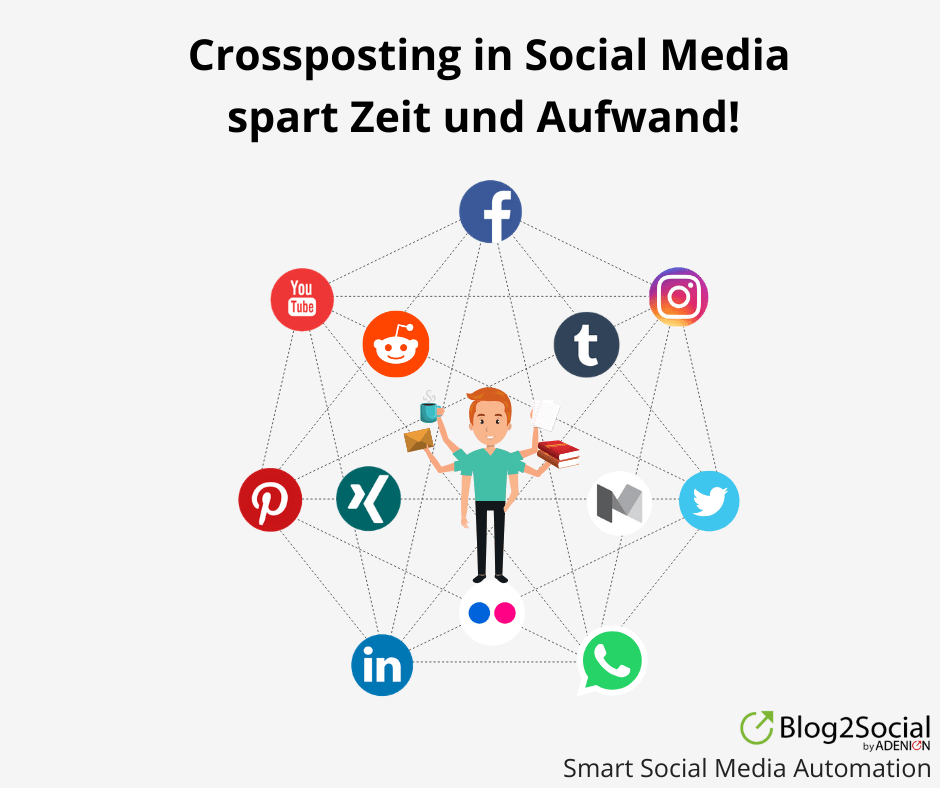
Was ist Crossposting?
Als Crossposting bezeichnet man das Teilen eines gleichen Beitrags auf verschiedenen Plattformen und Portalen. Oder aber auch das Posten auf einem Portal in verschiedenen Gruppen, Foren oder Diskussionen.
Über die Praxis des Cross-Postings wird viel diskutiert, denn sie kann sowohl negative als auch positive Wirkung entfalten. Doch ein intelligentes und gezielt eingesetztes Cross-Posting der mehrfachen Veröffentlichung ist ein nützliches und wirkungsvolles Werkzeug im Online-Marketing. Denn eine cross-mediale Distribution erzielt mehr Reichweite und Sichtbarkeit für die Inhalte.
Vor- und Nachteile des Cross-Posting in Social Media
Durch die gezielte Verteilung eines Beitrags (Content Seeding) in vielen verschiedene soziale Netzwerken und in anderen Online-Medien kann ein Beitrag mehr potentielle Leser erreichen. Eine weitreichende Verbreitung generiert mehr Touchpoints im Internet, über die Unternehmen, Marken und Produkte leichter gefunden werden.
Mit Hilfe von speziellen Software-Tools lässt sich das Cross-Posting ohne viel Arbeitsaufwand automatisch auf verschiedenen Kanälen planen und teilen. Doch es gibt wichtige Regeln, die dabei zu beachten sind.
Vorteile des Crosspostings in Social Media
Social Media Crossposting über viele verschiedene Netzwerke hinweg:
- Spart Zeit und reduziert den Aufwand im Social Media Marketing auf den verschiedenen Kanälen.
- Bringt die Inhalte schneller in mehr Social-Media-Kanäle.
- Schafft mehr Reichweite und erreicht mehr potentielle Leser in kürzerer Zeit.
- Unterstützt die mehrfache Verwertung von Inhalten (Content Recycling) in verschiedenen Medien und Kanälen.
Nachteile des Crosspostings in Social Media
- Die Social Media Netzwerke sind sehr verschieden. Nicht jeder Inhalt und jedes Medien-Format funktioniert in allen Netzwerken gleich.
- Ein gleichförmiges und unpersönliches Posten von Inhalten erzielt weniger Interaktion der Follower.
- Beiträge ohne persönliche Kommentare erzielen weniger Sichtbarkeit.
- In einigen Netzwerken gibt es strenge Regeln für das Cross-Posting: Zu viele identische Posts sind in einigen Netzwerken nicht zugelassen und werden gefiltert oder gelöscht.
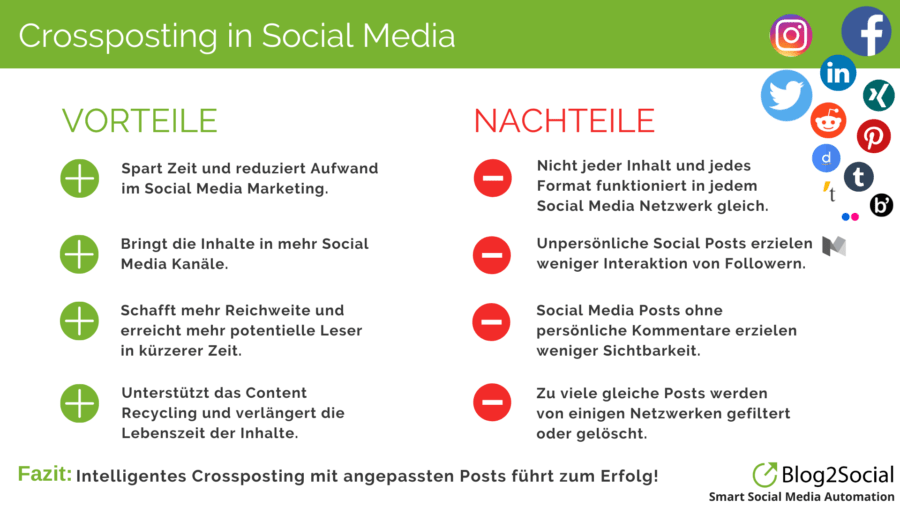
Wie funktioniert das Crossposting im Social Media Marketing?
Das Crossposting ist eine sinnvolle Strategie, um ein Thema bzw. einen Beitrag schnell in viele Social-Media-Kanäle zu bringen. Doch das Crossposting funktioniert nicht in allen sozialen Netzwerken gleichermaßen.
Jedes soziale Netzwerk bietet unterschiedliche Möglichkeiten, Regeln und Optionen, um Beiträge und Bilder bestmöglich zu präsentieren. Und auch die User reagieren unterschiedlich auf bestimmte Inhalte und Beitrags-Formate.
Tweets bei Twitter dürfen maximal 280 Zeichen umfassen und sollten möglichst auch Hashtags beinhalten. Bei Facebook können die Beiträge deutlich länger sein, dafür funktionieren hier Hashtags nicht so gut. Bei XING funktionieren Hashtags gar nicht, bei Instagram sollten es möglichst viele, aber maximal 30 Hashtags sein.
Nicht nur über verschiedene Netzwerke hinweg, sondern auch innerhalb von Netzwerken kann es sinnvoll sein, einen Beitrag nicht nur auf dem eigenen Profil oder die Unternehmensseite zu publizieren, sondern auch in passenden Foren, Newsgroups und Gruppen. Doch besonders in Gruppen und Foren gibt es sehr strenge Regeln für das Cross-Posting. So ist es zum Beispiel bei XING erlaubt, denselben Beitrag in maximal 3 Gruppen zu teilen. Auch bei Twitter gibt es neue Regeln, die das Cross-Posting gleicher Inhalte in einem oder auf mehreren Twitter Accounts begrenzen.
Ein erfolgreiches Crossposting in Social Media erfordert also eine intelligente Cross-Promotion Strategie. Erfolgreicher ist die Praxis einer gezielten Anpassung der Beiträge an die jeweiligen sozialen Netzwerke. Diese Strategie wird auch häufig als Cross-Promotion bezeichnet.
Crossposting und Cross-Promotion in der Praxis
Wir betreiben 5 Corporate Blogs für die verschiedenen Produkte und daran angeschlossen haben wir auch die entsprechenden Social-Media-Kanäle, die wir regelmäßig mit Inhalten füllen. Unsere Blogs fungieren hierbei als unsere Content-Zentrale und Seeding-Kanäle. Hier erstellen und veröffentlichen wir alle unsere Inhalte: Beiträge, Grafiken, Infografiken, Whitepapers, Checklisten, FAQs, Videos, Podcasts, etc.
Für das Cross-Posting und Content Seeding erstellen wir jeweils verschiedene Medien-Formate. Diese Medien-Formate seeden wir dann über unsere verschiedenen Online-Medien Kanäle.
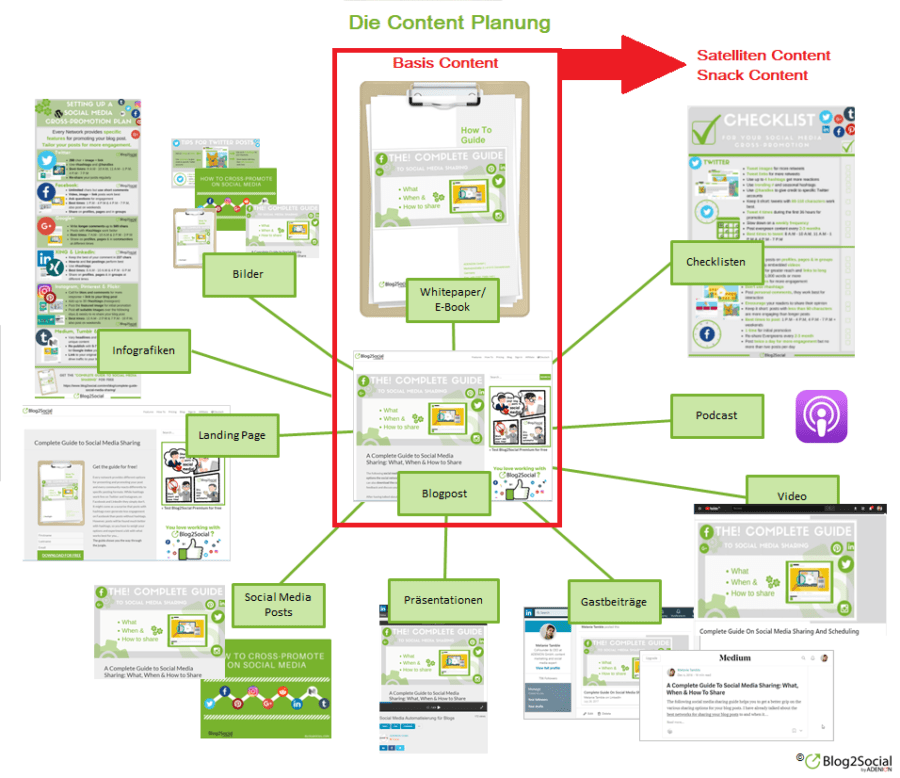
Über die verschiedenen Kanäle unterscheiden wir jeweils unsere Ansprache und auch die Darstellung unserer Posts, aber auch die Posting-Zeiten und die Frequenz, mit der wir posten.

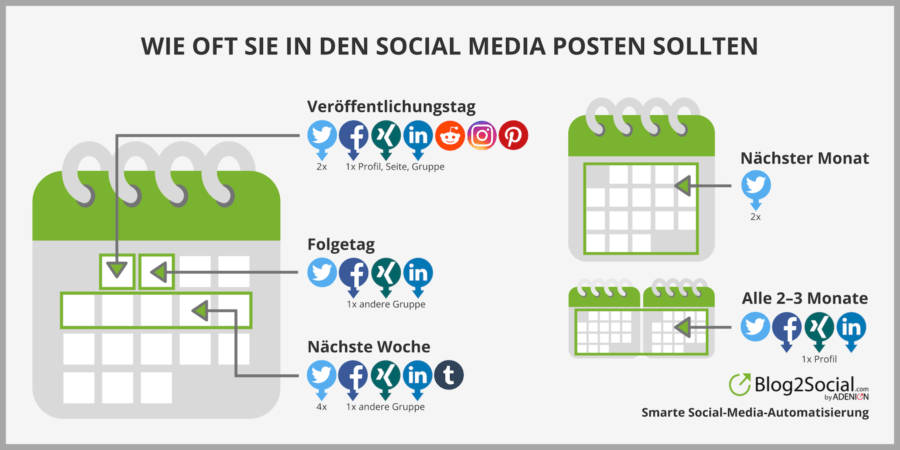
Das alles setzen wir mit einer konzertierten Strategie, Social Media Planung und Automatisierung um:
Die Klassiker: Twitter und Facebook
Twitter ist unser Hauptkanal, weil hier die meiste Interaktion stattfindet. Wir haben verschiedene Twitter Kanäle auf Deutsch und Englisch, damit wir vor allem unsere internationalen Kunden und Influencer gezielter erreichen können. Unsere Erfahrung ist, dass englischsprachige Beiträge für unsere deutschsprachige Community ok sind. Aber deutsche Beiträge auf einem Kanal, auf den wir internationale Kunden lenken, funktioniert nicht so gut. Daher haben wir einen deutschen und einen englischen Kanal aufgebaut. Auf Twitter posten wir wesentlich häufiger und mehr, als auf allen anderen Kanälen und hier kuratieren wir auch die meisten Beiträge.
Twitter hat vor geraumer Zeit neue Richtlinien für das Cross-Posting, Re-Posting und die Automatisierung eingeführt. Gleiche Tweets auf verschiedenen Twitter Accounts und wiederholte, identische Tweets sind nicht erlaubt. Bei Twitter cross-promoten wir alle unsere Beiträge und passen die Kommentartexte für die verschiedenen Kanäle an. Auch planen wir die Tweets an verschiedenen Tagen und zu unterschiedlichen Zeiten. Wir planen auch wiederholte Tweets mit jeweils leicht variierten Kommentartexten.
Für unsere Tweets recherchieren wir genau nach passenden #Hashtags zu unseren Themen, um uns gezielt in Diskussionen einzuklinken und nutzen @Handles, um Kooperationspartner und Influencer anzusprechen.
Facebook ist unser aktivster Dialog-Kanal. Auf Facebook cross-posten wir unsere Beiträge sowohl auf den persönlichen Profilen, als auch auf den Business-Seiten und in unserer Facebook Gruppe. Zusätzlich wählen wir gezielt passende Gruppen aus. Auf unserer Business Seite kommunizieren wir vornehmlich auf Englisch und zeigen die deutschsprachigen Beiträge auch nur der deutschsprachigen Community an.
Für Facebook halten wir die Kommentartexte kurz und prägnant und verwenden nur wenige Hashtags. Auf den persönlichen Profilen und in unserer Gruppe wählen wir eine noch etwas persönlichere Ansprache als auf den Business-Seiten.
XING und LinkedIn für Businesskontakte
Die Business-Netzwerke XING und LinkedIn sind für uns ebenfalls wichtige Kanäle. Daher nutzen wir auch hier persönliche Profile, Business-Seiten und bei LinkedIn auch Fokus-Seiten für unsere Produkte und Projekte. Auch die verschiedenen Gruppen und Communities für die Cross-Promotion und das Seeding von Beiträgen. LinkedIn nutzen wir verstärkt für unsere internationalen Kontakte und englischsprachigen Beiträge.
Für die XING und LinkedIn Posts nutzen wir eine ähnliche Form wie für Facebook, planen die Beiträge jedoch an unterschiedlichen Tagen und zu unterschiedlichen Zeiten. XING hat sehr strenge Regeln für das Cross-Posting in Gruppen, daher achten wir hier besonders darauf, dass wir die Texte und Bilder immer stark variieren.
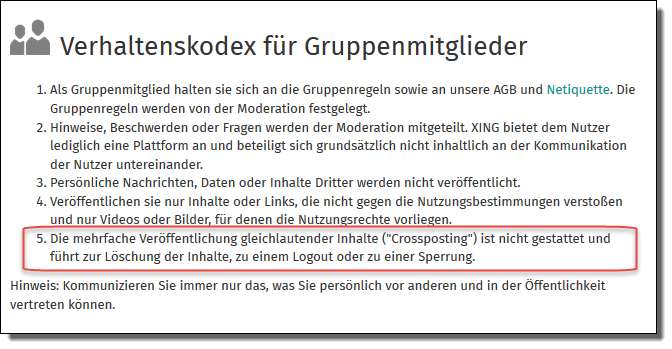
Mit Google My Business in den Suchindex
Außerdem nutzen wir Google My Business für die Veröffentlichung unserer Beiträge. Die Marketing-Power dieses kostenlosen Google Service wird häufig unterschätzt. Google My Business bietet die Möglichkeit, aktuelle Beiträge direkt auf den obersten Platz in den Suchindex zu bringen (Knowledge Panel). Google My Business ist also nicht nur ein Brancheneintrag. Mit den Google Posts können wir unsere Blogbeiträge, Fachbeiträge oder auch Aktionen und Kampagnen als Google Beiträge auf unserem Google My Business Profilen veröffentlichen. So sind unsere aktuellen Beiträge auch direkt im Google Suchindex sichtbar.
Visuelle Inhalte auf Instagram, Pinterest und Flickr
Die Bilder-Netzwerke Instagram, Pinterest und Flickr bringen vor allem viel Sichtbarkeit und Traffic aus den Bildersuchen der Suchmaschinen und den Social Media Netzwerken. Visuelle Elemente sind extrem wichtig im Social Web geworden. Aber auch hier gibt es große Unterschiede, denn Instagram funktioniert anders als Pinterest. Daher entwickeln wir für Pinterest auch spezielle Bildformate für unsere Beiträge.
Crossposting und Content Recycling mit Visuals
Visuelle Inhalte sind ein elementarer Bestandteil der Social Media Kommunikation geworden. Daher ist es sinnvoll, die Bilder auch beim Cross-Posting in den Fokus zu setzen.
Im Rahmen unserer Content Recycling Strategie erstellen wir für alle Beiträge jeweils verschiedene Visuals oder Infografiken, damit wir möglichst viel Bildmaterial für unsere Social Media Posts haben. Und das nicht nur bei Pinterest oder Instagram, sondern auch nochmal bei Twitter, Facebook, XING oder LinkedIn.
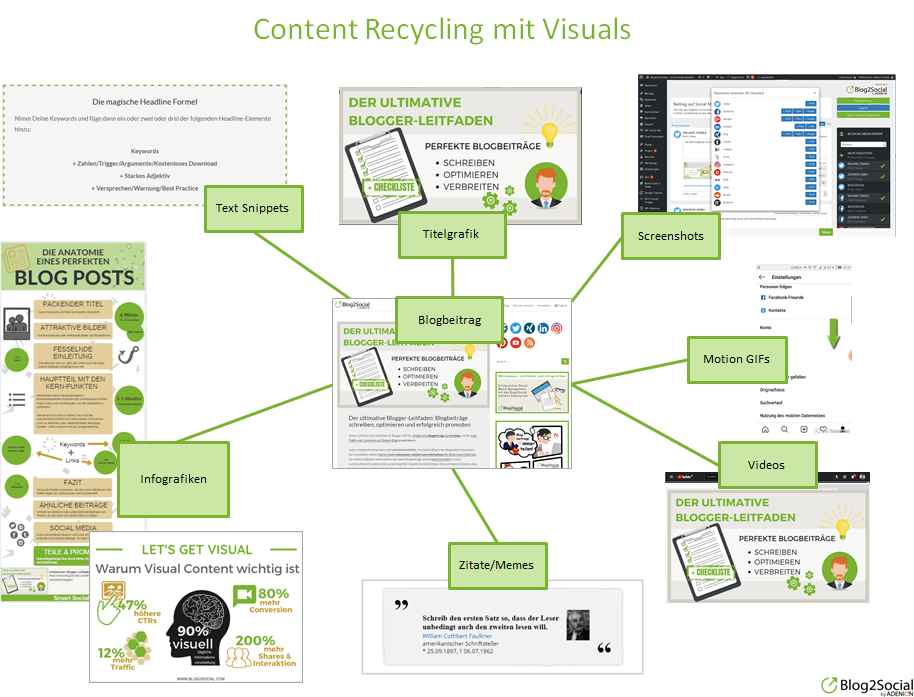
So können wir zum einen die Beiträge mit verschiedenen Bildaufhängern und Kommentaren posten, um zum Beispiel verschiedene Teilaspekte des Beitrags zu betonen, oder aber wir posten Infografiken auch separat nur auf bestimmten Netzwerken. So können wir unsere Inhalte mit verschiedenen Bildaufhängern und Kommentaren auch mehrfach posten, ohne uns zu wiederholen.
Reddit und Subreddits
Reddit ist vor allem für den internationalen Bereich interessant, denn es gibt hier Hunderte von sogenannten Subreddits zu bestimmten Themen, ähnlich wie bei den Gruppen und Communities der anderen sozialen Netzwerke. Hier teilen wir unsere englischsprachigen Beiträge in den jeweils passenden Subreddits.
Content Syndizierung
Redaktionelle Netzwerke wie Medium, Tumblr, Bloglovin‘ und Torial sind für uns weitere Kanäle, auf denen wir unsere Blogbeiträge syndizieren, also zweitverwerten. Entweder in einer gekürzten oder leicht veränderten Form oder auch komplett als syndizierter Beitrag.
Da unsere Beiträge oft recht lang sind, entwickeln wir hierfür in der Regel vorab eine gekürzte Fassung, die wir dann aber auf allen redaktionellen Netzwerken und auch für Online-Pressemitteilungen, etc. verwerten. Das ist für uns Teil unserer Content Recycling Strategie.
Bookmark-Communities
Und dann gibt es noch die Bookmark-Verzeichnisse wie Diigo, die vor allem im amerikanischen Raum sehr beliebt sind. In diesen Netzwerken werden einfach nur der Link und ein kurzer Kommentar mit Hashtags geteilt.
Tools für das Crossposting
Es gibt nützliche Software-Tools und Plugins, die dabei helfen, Beiträge automatisiert parallel in mehreren Netzwerken und auch mehrfach wiederholt in den Netzwerken zu veröffentlichen. Die meisten dieser Tools basieren auf einem ähnlichen Prinzip. Die gewünschten Netzwerke werden im Tool aktiviert und die Zugangsdaten über eine Schnittstelle zu den Netzwerken (API) im Tool gespeichert. Anschließend lassen sich über das Tool die Beiträge parallel über die Netzwerke teilen.
Die Tools unterscheiden sich in der Art und Anzahl der angeschlossenen Netzwerke sowie in den Möglichkeiten und Optionen, die Beiträge den Besonderheiten der Netzwerke und Communities anzupassen, zum Beispiel durch persönliche Kommentare, individuelle Bilder, #Hashtags oder @Handles. Auch unterscheiden sich die Tools in den Möglichkeiten für die zeitversetzte oder wiederholte Planung der Beiträge in den verschiedenen Netzwerken.
Cross-Social-Media-Automatisierung mit Blog2Social
Mit Hilfe von Blog2Social können wir sämtliche Beiträge für all unsere Kanäle mit wenigen Handgriffen individuell anpassen, mit verschiedenen Kommentaren, Hashtags oder Handles versehen, zeitversetzt planen und automatisiert teilen.
Neben den klassischen sozialen Netzwerken, sind auch Google My Business (Google Posts) und die redaktionellen Netzwerken wie Medium, Tumblr, Blogloving oder Torial angeschlossen. Für die redaktionellen Netzwerke bietet Blog2Social einen HTML Editor, um die Beiträge ggf. noch zu kürzen oder zu individualisieren. Man kann die Beiträge aber auch im Ganzen auf den jeweiligen Kanälen syndizieren. Hierfür werden entsprechende Canonical Tags mitgegeben, die den Originalbeitrag kennzeichnen.
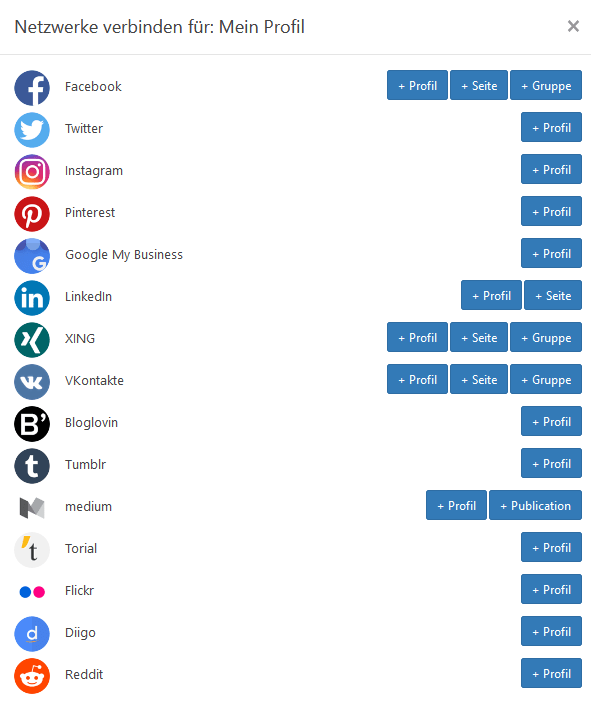
Individuelle Anpassungen sind sowohl individuell pro Social Media Post oder generell über Beitragsvorlagen (Post-Templates) möglich.
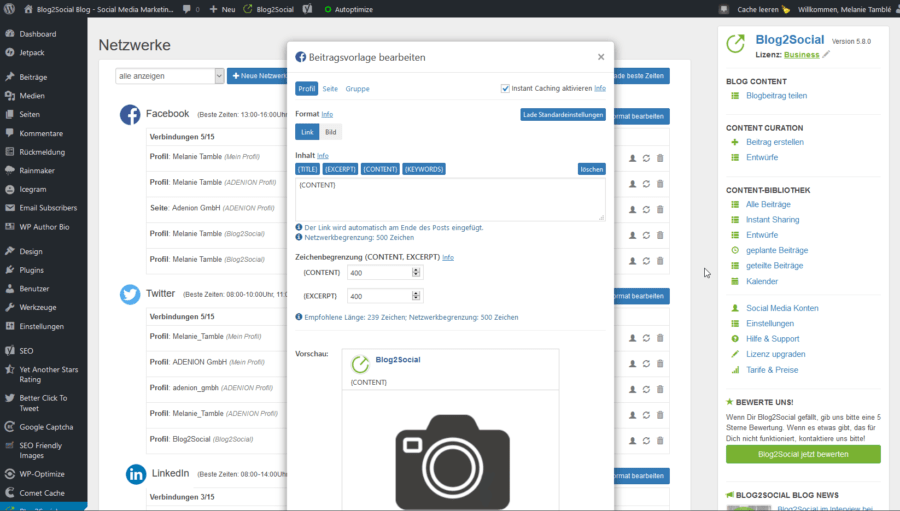
Mit Blog2Social können wir Textbeiträge und Links direkt aus dem Blog oder aus beliebigen Quellen, je nach Netzwerk wahlweise als Link-Post (mit Vorschau-Grafik) oder als Bild-Post teilen.
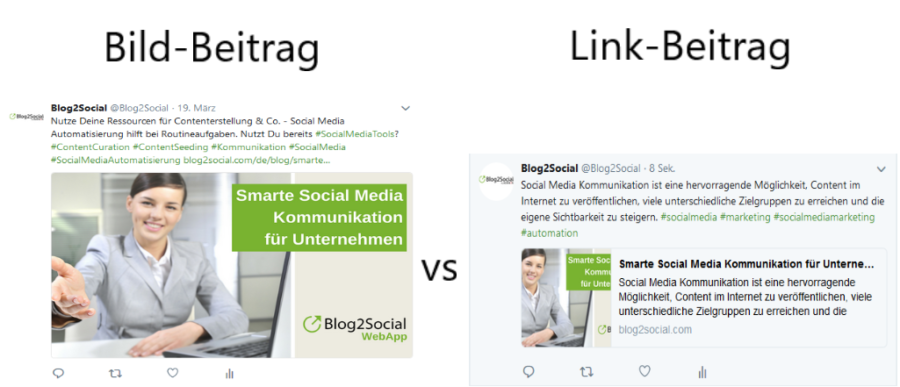
Bei einem Link-Post wird in der Vorschau (Preview) das Beitragsbild geteilt (bzw. das Bild, das in den OG Parametern definiert ist). Beim Bild-Post wird das Vorschau-Bild oder ein individuell definiertes Bild aus dem Beitrag oder aus der Mediathek geteilt. Die individuelle Bild-Auswahl lässt sich entweder über die Veränderung der OG-Parameter oder einfach durch Auswahl eines anderen Bildes aus der Mediathek definieren. Oder aber, man postet nur das Bild als Bild-Post, mit oder ohne Link zum Beitrag. Das hat den Vorteil, dass man den Beitrag auch mehrfach über die Social-Media-Kanäle seeden kann, ohne dass der Beitrag gleich aussieht.
Über den Beste Zeiten Planer und den Social Media Kalender lassen sich alle Social Media Beiträge flexibel nach einem vordefinierten Zeitschema automatisiert oder individuell pro Netzwerk planen und teilen.
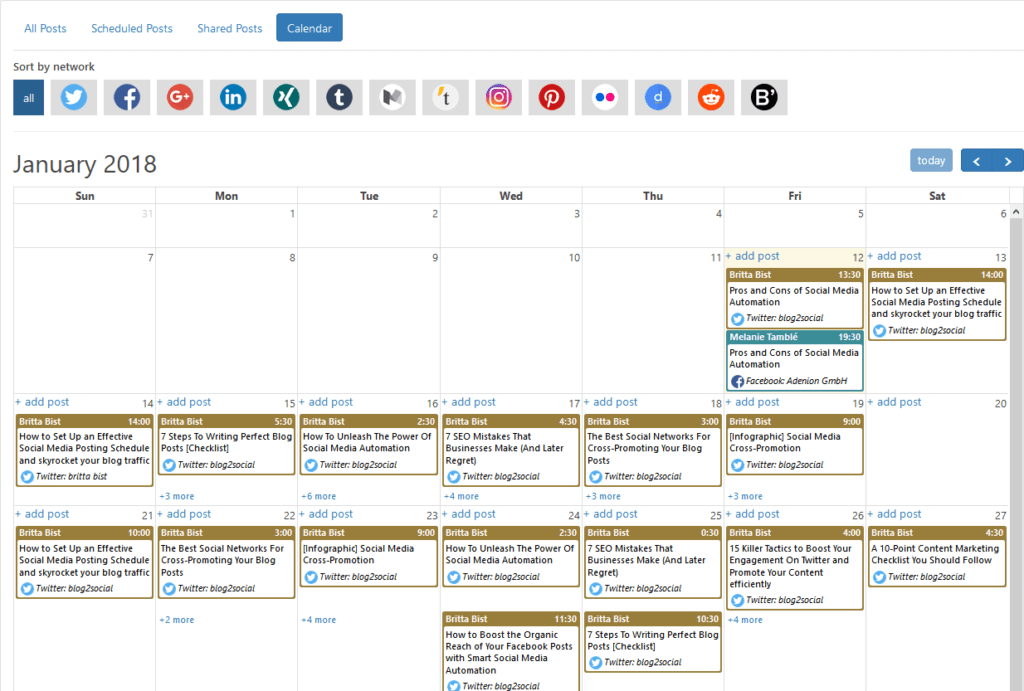
Über Blog2Social lassen sich auch Beiträge und Bilder ganz unabhängig vom Blog oder der WordPress Seite posten, per Link, per RSS-Import oder per Import über die Blog2Social Browser Extension. Mit der Browser Extension lassen sich beliebige Beiträge, Bilder oder andere Medien aus beliebigen anderen Quellen entweder direkt über den Browser teilen oder in WordPress oder der WebApp als Entwurf speichern und zu einem späteren Zeitpunkt planen und teilen.
Fazit
Crossposting in Social Media ist sinnvoll, denn es spart Zeit und führt zu mehr Reichweite für die geteilten Inhalte. Doch ein erfolgreiches Crossposting erfordert eine gezielte Strategie für die Anpassung der Social Media Posts an die verschiedenen Netzwerke und Communities. Social Media Tools unterstützen die Automatisierung der Planung und Distribution der Inhalte über die verschiedenen Kanäle. Die Tools sollten aber auch ein großes Spektrum an Möglichkeiten für die individuelle Anpassung der Beiträge an die sozialen Netzwerke und User bieten.
[Gesamt: 0 im Durchschnitt: 0]
Expertin für Content Marketing, Online PR und Social Media. Autorin und Bloggerin. Gründerin und geschäftsführende Gesellschafterin der ADENION GmbH.
Die Online-Dienste der ADENION GmbH unterstützen Unternehmen und Agenturen bei der täglichen Kommunikationsarbeit in den digitalen Medien.
PR-Gateway und Blog2Social ermöglichen eine einfache und schnelle Verteilung von Pressemitteilungen, Social Media News, Blogartikeln, Bildern und Dokumenten an Presseportale, Blogs, Newsdienste und Social Media.
toller geplanter post
tolle description
Gfycat Test

Test li post 🙂